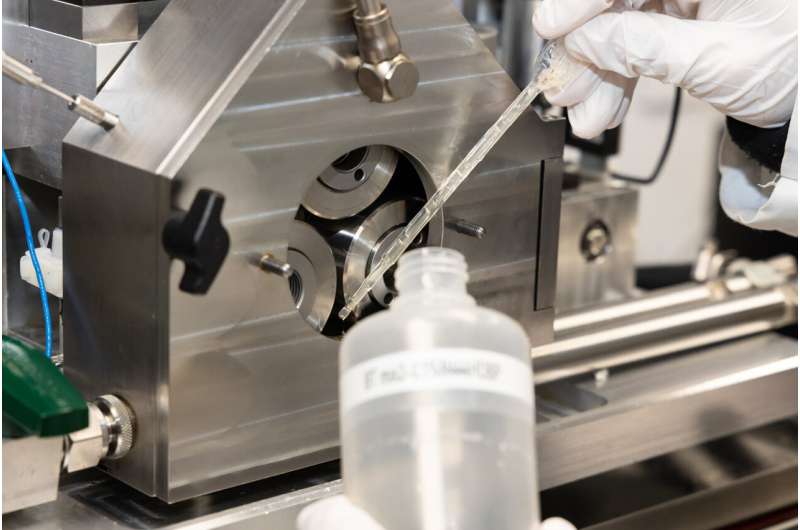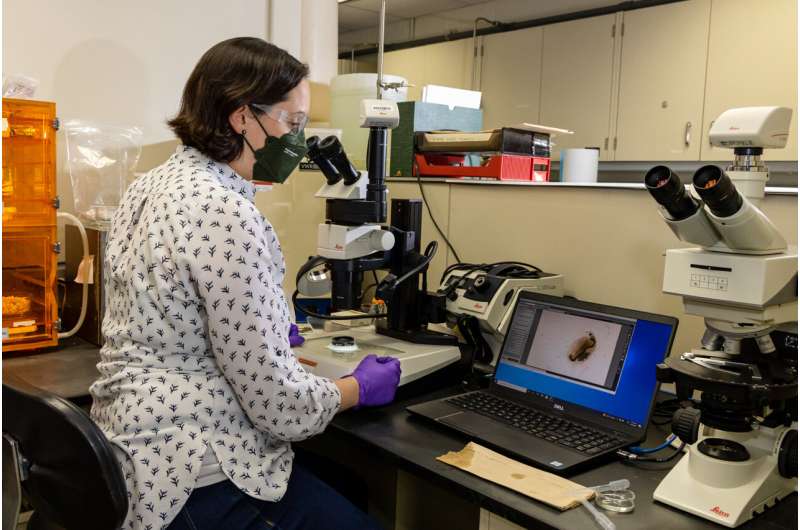This article has been reviewed according to Science X's editorial process and policies. Editors have highlighted the following attributes while ensuring the content's credibility:
fact-checked
peer-reviewed publication
trusted source
proofread
New eco-friendly lubricant additives protect turbine equipment, waterways

Scientists at the Department of Energy's Oak Ridge National Laboratory have developed lubricant additives that protect both water turbine equipment and the surrounding environment.
Each year, roughly 2.47 billion gallons of lubricating oil are consumed in the United States alone for engines and industrial machinery, according to DOE, with about half eventually finding its way into the environment.
While environmentally acceptable lubricants are available, they are not optimized with additives that can greatly improve performance while posing minimal environmental impact if accidentally released. To create nontoxic, biodegradable and high-performing lubricant additives for water power turbines, researchers turned to ionic liquids, or ILs: organic liquid salts that mix well with oil, reduce friction between bearings and gears, and are stable in a range of temperatures.
A team of materials and environmental scientists at ORNL worked together to design, synthesize and test top-candidate ILs of ammonium phosphate and phosphonium phosphate that provide a good mix of properties.
When added to base oils, the ILs demonstrated 50% less friction and a tenfold decrease in equipment wear compared to a commercially available gear oil, while meeting federal standards for environmental toxicity and biodegradability, as described in ACS Sustainable Chemistry & Engineering.
The project builds on more than 20 years of IL research at ORNL, including the development of lubricant additives designed to reduce engine wear and boost fuel economy in vehicles.
"Our previous work showed us that you could dramatically increase the performance of lubricants with the addition of just 1% or even a half-percent of ILs," said ORNL's Jun Qu, who leads the project and the Surface Engineering and Tribology group at ORNL.
This time around, scientists sought to create a nontoxic additive for use in turbines installed in aquatic environments, generating electricity using waves, tides, ocean and river currents. Although ILs are generally considered less toxic than conventional lubricant ingredients, their impact on the environment has not been closely studied.
"On the environmental side, there are three main factors we care about with these lubricants," said Teresa Mathews, lead for the Biodiversity and Ecosystem Health group at ORNL. "They have to be highly performing, we don't want them to be toxic to any aquatic organisms, and if there's a spill, we don't want the lubricants to be compounds that last in the environment. We want them to degrade very rapidly."
Pursuing a cleaner formula
The team first sought to eliminate potential toxic elements such as fluorine and chlorine and metals such as zinc and iron from the candidate ILs. They also focused on creating ILs made up of shorter hydrocarbon chains—chains containing fewer than six carbon atoms—which are generally considered to be less toxic.
"We found a four-carbon chain to be the sweet spot," Qu said. Going shorter than four carbons resulted in an IL that didn't mix well with oil and was less thermally stable, he added.
Friction testing was accomplished with metal pieces simulating turbine gears and bearings coated with a lubricant containing the IL. Resulting surface wear of the pieces was characterized using electron microscopy at the Center for Nanophase Materials Sciences, a DOE Office of Science user facility at ORNL.
These particular ILs are fairly straightforward to produce and can be easily scaled up for commercialization, said Huimin Luo, a chemist in ORNL's Manufacturing Science Division who led the chemical synthesis work.
To determine the additives' environmental impact, ORNL ecotoxicologist Louise Stevenson conducted toxicity and biodegradability tests in ORNL's Environmental Toxicology Laboratory, where assessments are routinely conducted for DOE, the Department of Defense and other agencies. Following Environmental Protection Agency protocols, the toxicity tests used Ceriodaphnia, tiny planktonic crustaceans commonly known as water fleas that sit at the bottom of the food chain, have a short life cycle and rapid reproduction rate, and are highly sensitive to environmental conditions.
Tiny plankton provide big insights
The organisms "are like canaries in a coal mine for aquatic toxicity because they are filter feeders and interact with a lot of water," Stevenson said. "In a seven-day test, we'll get three to four rounds of reproduction with daily hatching, so we can look for both lethal effects and sublethal effects such as reproductive and growth impacts that have an effect on population survival."

While the environmentally acceptable lubricant base oils had no effect on the crustaceans, the commercial lubricant additives and two early IL compounds were found to be extremely toxic to the organisms, resulting in 100% mortality within one to three days after exposure. The team's ultimate designs for short-chain ammonium phosphate and phosphonium phosphate IL additives resulted in 90-100% survival rates after seven days.
The final, top-performing IL-enhanced lubricants were also found to be highly biodegradable compared to standard lubricant additives. Testing involved exposing the compounds to aquatic microbes and then measuring the rate of carbon dioxide production as the microbes broke down the materials.
High-performing, environmentally friendly lubricants designed specifically for marine energy turbines are important for other reasons, including equipment durability. Lubricant technology currently in use for marine turbines was borrowed from wind turbines, which are serviced every six to 18 months, Qu said. But tidal turbines installed in the ocean or rivers are typically designed for service every six years and operate under much harsher conditions.
The project is expected to next focus on further development of IL lubricant additives specifically for use in tidal turbines operating in the ocean and exposed to potential seawater contamination and pressure and temperature extremes.
The project highlights the diverse expertise and capabilities assembled at ORNL to address a broad range of economic, environmental and societal challenges, the scientists noted.
Stevenson said, "Green chemistry is a hot topic, and this is an example of actually doing that and working together between materials scientists and environmental scientists to get at a solution in a collaborative, productive way."
More information: Xin He et al, Minimizing Toxicity and Optimizing Lubricity of Ionic Liquids for Eco-Friendly Lubrication, ACS Sustainable Chemistry & Engineering (2024). DOI: 10.1021/acssuschemeng.3c06194
Journal information: ACS Sustainable Chemistry & Engineering
Provided by Oak Ridge National Laboratory




















